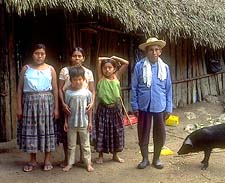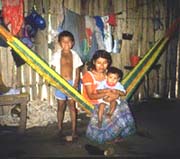| | | | 
Modern Mayan Lives
by Stephen Morgan, Proyecto Ak'TenamitA Brief History
The Kek'chi population of the Rio Dulce (Sweet River) area numbers over 10,000 and consists of many small villages situated along the river's edge and in the surrounding rain forest. They are relatively new communities; most are less than 50 years old. This is because many of their inhabitants were displaced from their original homes, in the mountainous region of Alta Verapaz, about 40 years ago by powerful finceros (landowners). Many of the evictions were due to the  search for more fertile land to create or extend coffee plantations, which produce one of Guatemala's most important exports. search for more fertile land to create or extend coffee plantations, which produce one of Guatemala's most important exports.As the history of the Mayan people had been full of such events ever since the Spanish conquest, many evicted villagers believed time was ripe for a change of strategy. They decided to move to more isolated areas, with land unsuitable for coffee growing. They hoped that in such distant areas, they and their families would be safe from eviction and that they would be able to create new communities for the Kek'chi people. That is why, today, the Kek'chi cover the largest geographical area of all the Mayan peoples, even though they are only the third largest linguistic group. The Kek'chi inhabit areas as diverse as the beaches of the Caribbean in both Belize and Guatemala, the dense jungle of the Peten and the Rio Dulce as well as the mountains of Alta Verapaz.The remoteness of these communities had many benefits during the late 1970's and early 1980's. At this time, the simmering civil war that had been fought for 15 years, finally erupted. Over 100,000 people died or disappeared, and more than half a million children were left as orphans (in a population of only 8 million). Again, the Kek'chi people in Verapaz were to suffer. One of the most notorious events during this period was the massacre at Panzos, where a joint force of army and landowners attacked a peaceful demonstration of Kek'chi people demanding land rights. Over 100 indigenous people died and the event led to an escalation of violence throughout the country. The villages in the Rio Dulce area grew larger during this period as refugees from the Verapaz area fled to safer, more remote, Kek'chi speaking areas.The Situation Today
The isolation of the Rio Dulce also has many negative aspects. One problem is that the area is only accessible by water. For most of the villages, the nearest health care is at the Project Ak'Tenamit (New Village). The journey there may take up to 8 hours paddling, and a walk of up to 3 hours. For all the inhabitants in this area the journey is difficult and many people die because of such distances. Minor illnesses such as stomach infections, parasites, infected wounds are all common and can cause very serious repercussions if not treated. In Guatemala, the number one killer is diarrhea (from Cholera), an illness that in the U.S. is viewed as little more than a minor inconvenience.The people are very poor. They have no electricity or running water. Very few people even possess a radio, and many have never seen a television. Houses are made of cane walls and palm  thatched roofs. The floors are dried mud. The life expectancy of the people in these villages is less than fifty. many infants die of poor health. People sleep on the floor, or, if they have a little money, in hammocks. Occasionally you find wooden slat beds but no mattresses. It is common for three generations to live in one house. thatched roofs. The floors are dried mud. The life expectancy of the people in these villages is less than fifty. many infants die of poor health. People sleep on the floor, or, if they have a little money, in hammocks. Occasionally you find wooden slat beds but no mattresses. It is common for three generations to live in one house.The diet is also poor. The central food is corn; a crop essential to both the Mayan stomachs and to their religious beliefs. Most families work on the "Milpa" (cornfield), planting two crops a year. The principle food derived from this is the tortilla, which is a flat, round bread of ground corn. For meals tortillas are often eaten with salt or chili. The Mayans also use the corn for drinks, as a mix of hot water, ground corn, and occasionally sugar. It is also used as the main ingredient in many other meals.Other crops include rice and beans, but there are many aldeas (villages) that do not grow these. Bananas are common in some aldeas; fruits such as oranges, coconuts and limes grow during their respective seasons. Those aldeas that are near the river's edge or the sea supplement their diet with fish. Hunting also occurs in some areas with deer and "Tapiscuintla" (Jungle Rat) being the most sought after animals. But they are not common. With the poor diet, malnutrition is widespread and made worse by intestinal worms. While the medical team at Ak'Tenamit visits these aldeas in order to improve health and nutrition, there is still very much work to do. In the field of education there are also many problems. The area is often neglected by the Government Education Department which tends to concentrate on areas closer to the capital of Guatemala City. Consequently, it is typical to find run-down schools--or no schools at all--in the Rio Dulce area. There are few school materials, like pencils and chalk, very high levels of truancy by students as well as occasional absence by teachers. Only one in twenty girls in our area finish primary school. Illiteracy affects over 70% of the villagers. These difficulties lead to a distrust of education and make it far harder to explain how it can help improve health and nutrition, increase income and generally benefit their communities. Our hope is that better education, which plays a vital part in improving these people's lives, can be made an enjoyable and rewarding experience. In the field of education there are also many problems. The area is often neglected by the Government Education Department which tends to concentrate on areas closer to the capital of Guatemala City. Consequently, it is typical to find run-down schools--or no schools at all--in the Rio Dulce area. There are few school materials, like pencils and chalk, very high levels of truancy by students as well as occasional absence by teachers. Only one in twenty girls in our area finish primary school. Illiteracy affects over 70% of the villagers. These difficulties lead to a distrust of education and make it far harder to explain how it can help improve health and nutrition, increase income and generally benefit their communities. Our hope is that better education, which plays a vital part in improving these people's lives, can be made an enjoyable and rewarding experience.
| |

 search for more fertile land to create or extend coffee plantations, which produce one of Guatemala's most important exports.
search for more fertile land to create or extend coffee plantations, which produce one of Guatemala's most important exports. thatched roofs. The floors are dried mud. The life expectancy of the people in these villages is less than fifty. many infants die of poor health. People sleep on the floor, or, if they have a little money, in hammocks. Occasionally you find wooden slat beds but no mattresses. It is common for three generations to live in one house.
thatched roofs. The floors are dried mud. The life expectancy of the people in these villages is less than fifty. many infants die of poor health. People sleep on the floor, or, if they have a little money, in hammocks. Occasionally you find wooden slat beds but no mattresses. It is common for three generations to live in one house. In the field of education there are also many problems. The area is often neglected by the Government Education Department which tends to concentrate on areas closer to the capital of Guatemala City. Consequently, it is typical to find run-down schools--or no schools at all--in the Rio Dulce area. There are few school materials, like pencils and chalk, very high levels of truancy by students as well as occasional absence by teachers. Only one in twenty girls in our area finish primary school. Illiteracy affects over 70% of the villagers. These difficulties lead to a distrust of education and make it far harder to explain how it can help improve health and nutrition, increase income and generally benefit their communities. Our hope is that better education, which plays a vital part in improving these people's lives, can be made an enjoyable and rewarding experience.
In the field of education there are also many problems. The area is often neglected by the Government Education Department which tends to concentrate on areas closer to the capital of Guatemala City. Consequently, it is typical to find run-down schools--or no schools at all--in the Rio Dulce area. There are few school materials, like pencils and chalk, very high levels of truancy by students as well as occasional absence by teachers. Only one in twenty girls in our area finish primary school. Illiteracy affects over 70% of the villagers. These difficulties lead to a distrust of education and make it far harder to explain how it can help improve health and nutrition, increase income and generally benefit their communities. Our hope is that better education, which plays a vital part in improving these people's lives, can be made an enjoyable and rewarding experience.
![]()
